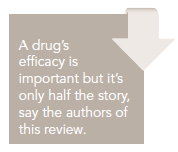Publication
Article
Cardiology Review® Online
The New Weight-Loss Drugs: Lorcaserin and Phentermine-Topiramate
Author(s):
The authors of this review believe the efficacy of a drug is important, but it is not the full story.

Kena Lanham, PharmD, BCPS
Review
Woloshin S, Schwartz LM. The new weight-loss drugs, lorcaserin and phentermine-topiramate [published online February 10, 2014]. JAMA Intern Med. doi:10.1001/jamainternmed.2013.14629.

One of every 3 Americans is obese, a condition that cost an estimated $147 billion in medical expenses in 2008 US dollars.1 Patients with obesity are at increased risk for disease states such as type 2 diabetes mellitus, hypertension, hyperlipidemia, coronary artery disease, and stroke, and their associated increased risks of mortality. The Centers for Disease Control and Prevention (CDC) recommends a combination of healthy diet, increased physical activity, behavioral therapy, pharmacotherapy, and surgery as options to reduce body weight and the risk of developing obesity-associated disease states. Relatively few pharmacotherapy options exist because of health risks associated with medications that treat obesity. Medications previously approved for longterm weight loss (dexfenfluramine and sibutramine) are no longer available because of their associations with adverse events such as cardiac valvulopathy and increased risk for ischemic events, respectively.2
In 2012 the FDA approved phentermine/topiramate extended release (PHEN/TPM-ER) (Qysmia) and lorcaserin (Belviq), 2 new agents for chronic weight management to be used in addition to a reduced-calorie diet and exercise.2 Both were approved following initial rejection by the FDA, and both must be further evaluated through postmarketing trials to investigate cardiovascular risks. Drs. Woloshin and Schwartz of The Center for Medicine and the Media at the Dartmouth Institute for Health Policy and Clinical Practice present a thorough review of the weight loss associated with both medications. Phentermine-topiramate was associated with 7% more weight loss than the placebo groups, and such weight loss was maintained over an additional year. Lorcaserin resulted in 3% more body weight lost but some weight gain over a year of follow-up.
In their review, the authors question the safety of the new agents. They conclude from the reviewed data that PHEN/TPM-ER may have more weight loss benefit than lorcaserin but at the expense of increased health risks. Citing safety concerns, the authors argue against the FDA’s decision to approve both agents. PHEN/TPM-ER’s labeling lists metabolic acidosis and memory, attention, and language problems as common serious harms, and paresthesias and dry mouth as common adverse drug effects. Lorcaserin labeling also lists potential serious harms affecting memory, attention, and language, but valvular regurgitation is the most concerning of the potential serious harms.
To further their case, Drs. Woloshin and Schwartz note that the FDA’s decision to approve PHEN/TPMER and lorcaserin conflicts with that of the European Medicines Association (EMA), which failed to approve both agents. The EMA cited concerns about cancer and psychiatric and valvular risks with lorcaserin, cardiovascular risks with phentermine, and the psychiatric and cognitive effects of topiramate. The EMA rejected PHEN/TPM-ER twice and lorcaserin once before the manufacturers withdrew lorcaserin’s application in May 2013. Although the FDA approved both agents on their second applications, Drs. Woloshin and Schwartz argue that concerns about serious cardiovascular risk questions remain unanswered. The FDA also acknowledged these remaining issues in its approval letter, requiring postapproval studies be performed to ensure the exclusion of the cardiovascular risks seen in other agents developed and approved for obesity treatment but later removed from the market.
The authors point out, however, that almost onethird of the medications approved in 2008 for which the FDA required postmarketing studies were not completed by their commitment dates in 2013. According to Clinicaltrials.gov, lorcaserin is currently recruiting for such a trial, to be completed in 2018. However, there are no such planned studies listed for PHEN/ TPM-ER. Due to the unknown adverse cardiovascular risks of these agents and the proposed use in a population at risk for such events, the authors concluded that these 2 agents are “slim pickings.”
CommentaryAre Weight-Loss Drugs Worth the CV Risk?
Treatment options for weight management are determined through an assessment of body mass index (BMI), waist circumference, and overall risk. A patient is classified as overweight with a BMI of 25 to 29.9, or obese with a BMI over 30.2 Waist circumference can be used to determine a patient’s risk of developing obesity-related health issues with BMIs between 25 and 34.9. A measurement greater than 40 inches in a female or 35 inches in a male indicates an excess of abdominal fat, which is indicative of increased health risk and can also be used to measure the success of weight-management programs.
Weight loss is associated with decreases in cardiac risk factors, and some studies show decreased mortality risk as a result of weight loss.2 In order to achieve such loss, the CDC recommends a comprehensive weight-management program, including dietary restrictions, physical activity regimens, and behavioral therapy. Pharmacotherapy options may be considered for patients who have either a BMI greater than 30 (obesity) or greater than 27 (overweight) with concomitant obesity-associated disease states. In order for a medication to be considered effective as a weight-management option, the FDA requires that at least 1 of 2 criteria be fulfilled. One, the patients in the treatment arm must lose at least 5% more weight than those in the placebo arm, reflecting the significance of decreasing cardiovascular risk at that level of weight loss.3 The second criterion is that at least 35% of the patients in the study arm lose at least 5% of their body weight. This criterion accounts for incorporation of a lifestyle modification component of all weight-loss studies.
As pointed out by Drs. Woloshin and Schwartz, a medication’s ability to induce weight loss is only half the story. The history of the pharmacologic management of obesity is marred by increased postmarketing restrictions and multiple withdrawals from the market due to serious adverse events.3 Amphetamine analogues such as phentermine were restricted to short-term use by the FDA due to abuse potential. The introduction of the serotonergic agents, fenfluramine-dexfenfluramine (fen-phen), utilized the appetite-suppressive effects of serotonin to induce long-term weight loss. However, these drugs were soon associated with valvular damage and pulmonary hypertension and were removed from the market. Sibutramine (Meridia) was brought to market in 1997 but with cautionary use in patients with cardiovascular disease due to the potential to increase blood pressure and heart rate. A cardiovascular outcomes trial revealed increased risk of cardiovascular events, and sibutramine was removed from the market in 2010. Prior to the approval of lorcaserin and PHEN/TPM-ER, the only FDA-approved agent for long-term weight loss was orlistat (Xenical), a lipase inhibitor, which is associated with gastrointestinal adverse effects, but no increased risk of cardiovascular effects have been determined to date.4
Phentermine has been marketed for decades as a short-term weight loss agent in doses ranging from 15 mg to 37.5 mg.5 Topiramate is an anti-epileptic medication that is also used to treat migraines. Topiramate alters taste, appetite, and metabolism through unknown mechanisms on carbonic- anhydrase and gamma-aminobutyric acid (GABA) transmission. Although topiramate commonly causes nervous system—related adverse effects and is a known teratogen, there are no real cardiovascular risks associated with its use. Phentermine suppresses appetite through its amphetamine-like induced release of norepinephrine; dopamine and serotonin do so to a lesser degree. Although multiple studies show decreases in blood pressure and heart rates, tachycardia and palpitations are commonly seen with phentermine.5 Likewise, palpitations were reported in up to 2.4% of patients in the treatment arms of the PHEN/TPM-ER trials. Jordan et al reported on available clinical trial data and noted no apparent increased cardiovascular risk (hazard ratio [HR] for cardiovascular death, MI, stroke: 0.84; 95% confidence interval [CI], 0.26- 2.64) associated with PHEN/TPM-ER, although no statistical significance can be conferred from the low event rate and short (1-year) follow-up.5 An assessment of the effect of PHEN/TPM-ER on dyslipidemia and blood pressure in subsets of patients from the phase 3 CONQUER study added to the benefit analysis of PHEN/TPM-ER, as significant weight loss led to improvements in both cardiovascular risk factors.6
Lorcaserin exerts its appetite-suppressive effect through selective inhibition of the serotonin 5-HT2C receptor.7 The agent has very little affinity for the other 5-HT2 receptors—5-HT2A, thought to be responsible for hallucinations, and 5-HT2B, the proposed mediator for the valvular adverse effects of dexfenfluramine. Nevertheless, lorcaserin does have the theoretical potential to have the same detrimental valvular effects. An echocardiographic analysis of lorcaserin’s impact on valve function did not show a statistically significant difference in the development of FDA-defined valvulopathy (risk ratio, 1.16 [95% CI, 0.81- 1.67]).8 However, more patients developed valvulopathy with lorcaserin (2.37%) than without (2.04%). The authors faulted greater weight loss with the agent as a partial explanation of that difference.
Considering that losing weight is not an emergency and that these medications have not been shown to be worth the cardiovascular risk, the authors of this review make a strong argument against approval of these medications. While there are not yet data showing any significant CV risk associated with PHEN/TPM-ER and lorcaserin, with the large population of patients that may take these medications, time and real-world experience will provide stronger evidence either in favor of or opposed to the safety of these new agents. Until then, prescribers should be extra cautious about monitoring patients’ response to these agents and discontinue them if desired weight loss (5% of body weight) is not achieved within 12 weeks of starting to take either drug, per the labeling of the agents.
References
1. US Centers for Disease Control and Prevention. Adult obesity facts. www.cdc.gov/obesity/data/adult.html.
2. National Heart, Lung, and Blood Institute Obesity Education Initiative Expert Panel on the Identification, Evaluation, and Treatment of Obesity in Adults. Clinical guidelines on the identification, evaluation, and treatment of overweight and obesity in adults: the Evidence Report. NIH Publication No. 98-4083; 1998. www.ncbi.nlm.nih.gov/books/NBK1996.
3. Colman E. Food and drug administration’s obesity drug guidance document: a short history. Circulation. 2012;125:2156-2164.
4. Yanovski S, Yanovski J. Long-term drug treatment for obesity: a systematic and clinical review. JAMA. 2014;311:74-86.
5. Jordan J, Astrup A, Engeli S, Narkiewicz K, Day W, Finer N. Cardiovascular effects of phentermine and topiramate: a new combination for the treatment of obesity [published online March 11, 2014]. J Hypertension. 2014;32.
6. Davidson M, Tonstad S, Oparil S, Schwiers M, Day W, Bowden C. Changes in cardiovascular risk associated with phentermine and topiramate extended-release in participants with comorbidities and a body mass index ≥27 kg/m2. Am J Cardiol. 2013;111:1131-1138.
7. Martin C, Redman L, Zhang J, et al. Lorcaserin, a 5-HT2c receptor agonist, reduces body weight by decreasing energy intake without influencing energy expenditure. J Clin Endocrinol Metab. 2011;96:837-845.
8. Weissman N, Sanchez M, Koch G, Smith S, Shanahan W, Anderson C. Echocardiographic assessment of cardiac valvular regurgitation with lorcaserin from analysis of 3 phase 3 clinical trials. Circ Cardiovasc Imaging. 2013;6:560-567.
About the Author
K
ena
J. L
anham
, PharmD, BCPS,
is a Cardiovascular Clinical Pharmacist at St. Vincent Indianapolis Hospital and Assistant Professor of Pharmacy Practice at Butler University in Indianapolis, IN.






